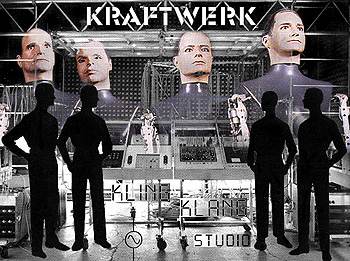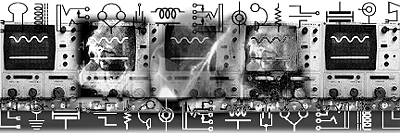D>Elektro 1.2 - |> expanded concept <|
|> Experiments | Sounds + Concepts |
It was the time which was used for the research and manipulation of sounds and structures, that one couldn't have payed, had it been spent in a normal recording-studio.
The new possibilities and instruments called for time to explore them in depth. High time for sound-research.
| "There
is so much in music that can't be put down in notes, especially the
sound. And here the electronics are offering a whole new range of possibilities. That is why for me a mixing-board has always been a musical instrument. Listen to the thunder on 'Irrlicht'. On this I had used a built-out Hammond reverb-spring as an instrument of it's own - I've simply plugged it from the upper side." |
The musicians acquainted themselves with the necessary details and facts - and hence weren't depending on sound-engineers and other experts. They moved closer to the technologies of sounds and to the possibilities of using the studio as a tool for electronically expressing themselves.

|
"Our instrument is really the Kling Klang studio - it existed from the beginning as a part of the group, like a 'mothership' from which everything originates."
Ralf Huetter [Kraftwerk]
|
| "We
spend a lot of time with inventing and constructing our own instruments
and also on our visual appearance. It is not 'just' about the music,
but about the connection
of engineer's work, art and music."
Ralf Huetter [Kraftwerk]
|
Old and new technologies were combined - the formerly acquired, and in parts academical knowledge, was put on day-to-day trial in unusual sound-experiments.
And simultaneous to the expanding of the notion of sound, the inevitable expanding of the notion of what an instrument is - or could be - took place.

| "In
the beginning there were no instruments
that could repeat sounds. We were working with echo-loops and tape-machine,
we copied sounds a dozen times to achieve repeated rhythms. We were using everything to create new sounds and listening-experiences." These were at first gadgets originally used for measure- and control-engineering, like oscillators, sine- and frequence-generators. Those were hooked up to each other, send through a delay and so forth..."
Edgar Froese [Tangerine Dream]
|
| "In
1971 Kraftwerk was still without a drummer, so I bought a cheap drum
machine wich had some preset dance rhythms. By changing the basic
sounds with tape echo and filtering we made the rhythm tracks for
our second album. Our instrumental sounds came from home-made oscillators and an old Hammond Organ that gave us various tonal harmonies with its drawbars. We manipulated the tapes at different speeds for further effects. We couldn't have achieved these sounds with a traditional drummer. Later on with our two electronic percussionists, we worked for months to develop that system, and it changed our lives.
Florian Schneider [Kraftwerk] |
A new phenomenon.
| D>Elektro |1.2.2| |>Sounds + Elements<| |
| |> Studio | Sound | Laboratory <| |
| |>..Sounds + Elements..|> | |
| <| Rwd: | Life | Work | Music | | |
| |> Fwd: | Machine | Play | Sample | |